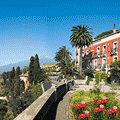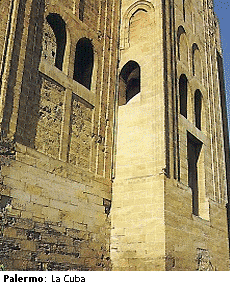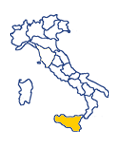Friday, 19 April 24 - 08:28 am
 |
|

 |
|
|
|
|

Palermo Hotels

Reserve Palermo Hotels: save up 70% on rooms!
Compare offers & book on line at hotel's web sites. |
|

|
|
Palermo Guide Italy
Historical buildings and monuments
|
|
|
|
|
Historical buildings and monuments
The most interesting historical buildings and monuments in Palermo
- Palazzo dei Normanni
In the 9th century, the Arab emirs built this majestic building. When they were ousted from Sicily, the building was transformed into a luxurious palace by the Normans, who extended it and made it even more beautiful. During the reign of Frederick II, the Palace enjoyed a period of splendor, and became the center of cultural life in the city, as the headquarters of the “Sicilian School”.
The internal courtyards, the huge marble staircase, the towers and the extravagant great hall are sights to be seen.
The palace houses the spectacular Cappella Palatina inside, which was also built by the Normans.
Palazzo dei Normanni has been the seat of the Regional Sicilian Assembly since 1947.
- Fontana Pretoria
This wonderful sixteenth-century fountain can be found in the center of the square carrying the same name. It was built by the Florentine sculptor Francesco Camilliani, and originally decorated the garden of a villa in Tuscany. It was then purchased by the city of Palermo, dismantled and rebuilt in Piazza Pretoria.
The fencing around the fountain, designed by Giovan Battista Basile, was built in 1858.
- Castello della Zisa
In Europe, this is one of the best buildings built in Arabic style. Its name comes from the Arabic word “al-aziz” that means “the splendid one”. This indeed splendid, charming castle was built by Arabic architects on the wishes of the Norman king William II d’Altavilla and was completed in 1175. It was later transformed into a fortress and then into a residence for aristocratic families. It is now the home to the Museum of Islam.
- La Cuba
There is not much information available about this mysterious Norman building, built by William II d’Altavilla in 1180. Its original purpose is unclear, although we know that it was used as a lazaretto – a leper’s hospital - and later as a barracks for the Spanish garrisons. Some old papers state that it was once surrounded by a luxuriant park and a large lake named Pescheria.
- Santa Maria dello Spasimo
This “almost” church, that can be seen in the Kalsa area of the city, dates back to the beginning of the sixteenth century when, still unfinished, the building was allocated to another use. Due to the threat of a Turkish invasion, Santa Maria dello Spasimo was in fact transformed into a defense bulwark for the city. Later, during a plague epidemic in Palermo, the area was used as a lazaretto hospital and then as a warehouse. The building has now become the site of important cultural events.
- Teatro Massimo
The Teatro Massimo is one of the largest opera theaters in Europe and is one of Palermo’s most important buildings.
The theater was designed by Gian Battista Basile around 1868 and was built by his son Ernesto, who supervised the works starting from 1891. This change of hands resulted in a classical style exterior (inherited from the original project) and Liberty style inside, following the work of Ernesto Basile. In 1997, the theater was renovated and reopened to the public, after twenty years of neglect and disuse.
Go to directories of the Web Sites
|
|
|
|
|
Acquista la tua visibilità su Travel Plan
|
|
|
|





